Antibody data
- Antibody Data
- Antigen structure
- References [2]
- Comments [0]
- Validations
- Western blot [1]
- Immunocytochemistry [2]
- Chromatin Immunoprecipitation [1]
- Other assay [2]
Submit
Validation data
Reference
Comment
Report error
- Product number
- 720352 - Provider product page

- Provider
- Invitrogen Antibodies
- Product name
- ZNF217 Polyclonal Antibody
- Antibody type
- Polyclonal
- Antigen
- Synthetic peptide
- Description
- This antibody is predicted to react with Monkey, Pig, Rabbit
- Reactivity
- Human
- Host
- Rabbit
- Isotype
- IgG
- Vial size
- 100 μg
- Concentration
- 0.5 mg/mL
- Storage
- Store at 4°C short term. For long term storage, store at -20°C, avoiding freeze/thaw cycles.
Submitted references TBX2 acts as a potent transcriptional silencer of tumour suppressor genes through interaction with the CoREST complex to sustain the proliferation of breast cancers.
Epigenetic modulation reveals differentiation state specificity of oncogene addiction.
McIntyre AJ, Angel CZ, Smith JS, Templeman A, Beattie K, Beattie S, Ormrod A, Devlin E, McGreevy C, Bothwell C, Eddie SL, Buckley NE, Williams R, Mullan PB
Nucleic acids research 2022 Jun 24;50(11):6154-6173
Nucleic acids research 2022 Jun 24;50(11):6154-6173
Epigenetic modulation reveals differentiation state specificity of oncogene addiction.
Khaliq M, Manikkam M, Martinez ED, Fallahi-Sichani M
Nature communications 2021 Mar 9;12(1):1536
Nature communications 2021 Mar 9;12(1):1536
No comments: Submit comment
Supportive validation
- Submitted by
- Invitrogen Antibodies (provider)
- Main image
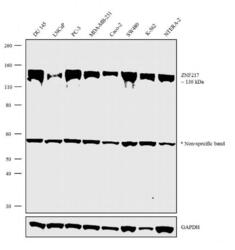
- Experimental details
- Western blot analysis was performed on Modified Whole cell extracts (1% SDS) (30 µg lysate) of DU 145 (Lane 1), LNCaP (Lane 2), PC-3 (Lane 3), MDA-MB-231 (Lane 4), Caco-2 (Lane 5), SW480 (Lane 6), K-562 (Lane 7) and NTERA-2 (Lane 8). The blots were probed with Anti-ZNF217 Rabbit Polyclonal Antibody (Product # 720352, 2 µg/mL) and detected by chemiluminescence using Goat anti-Rabbit IgG (Heavy Chain) Superclonal™ Secondary Antibody, HRP conjugate (Product # A27036, 0.2 µg/mL, 1:5000 dilution). A 130 kDa band corresponding to ZNF217 was observed across the cell lines tested. Along with the desired band, non-specific band at ~58 kDa was observed in the cell lines tested. Known quantity of protein samples were electrophoresed using Novex® NuPAGE® 4-12% Bis-Tris gel (Product # NP0322BOX), XCell SureLock™ Electrophoresis System (Product # EI0002) and Novex® Sharp Pre-Stained Protein Standard (Product # LC5800). Resolved proteins were then transferred onto a nitrocellulose membrane with iBlot® Dry Blotting System (Product # IB21001). The membrane was probed with the relevant primary and secondary Antibody following blocking with 5% skimmed milk. Chemiluminescent detection was performed using Pierce™ ECL Western Blotting Substrate (Product # 32106).
Supportive validation
- Submitted by
- Invitrogen Antibodies (provider)
- Main image
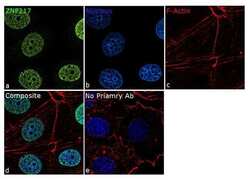
- Experimental details
- For immunofluorescence analysis, MCF7 cells were fixed and permeabilized for detection of endogenous ZNF217using Anti- ZNF217 Rabbit Polyclonal Antibody (Product # 720352, 2 µg/mL) and labeled with Goat anti-Rabbit IgG (H+L) Superclonal™ Secondary Antibody, Alexa Fluor® 488 conjugate (Product # A27034, 1:2000). Panel a) shows representative cells that were stained for detection and localization of ZNF217 protein (green), Panel b) is stained for nuclei (blue) using SlowFade® Gold Antifade Mountant with DAPI (Product # S36938). Panel c) represents cytoskeletal F-actin staining using Rhodamine Phalloidin (Product # R415, 1:300). Panel d) is a composite image of Panels a, b and c clearly demonstrating Nuclear localization of ZNF217. Panel e) represents control cells with no primary antibody to assess background. The images were captured at 60X magnification.
- Submitted by
- Invitrogen Antibodies (provider)
- Main image
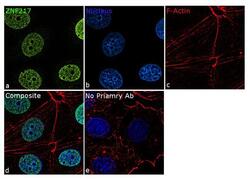
- Experimental details
- For immunofluorescence analysis, MCF7 cells were fixed and permeabilized for detection of endogenous ZNF217using Anti- ZNF217 Rabbit Polyclonal Antibody (Product # 720352, 2 µg/mL) and labeled with Goat anti-Rabbit IgG (Heavy Chain) Superclonal™ Secondary Antibody, Alexa Fluor® 488 conjugate (Product # A27034, 1:2000). Panel a) shows representative cells that were stained for detection and localization of ZNF217 protein (green), Panel b) is stained for nuclei (blue) using SlowFade® Gold Antifade Mountant with DAPI (Product # S36938). Panel c) represents cytoskeletal F-actin staining using Rhodamine Phalloidin (Product # R415, 1:300). Panel d) is a composite image of Panels a, b and c clearly demonstrating Nuclear localization of ZNF217. Panel e) represents control cells with no primary antibody to assess background. The images were captured at 60X magnification.
Supportive validation
- Submitted by
- Invitrogen Antibodies (provider)
- Main image
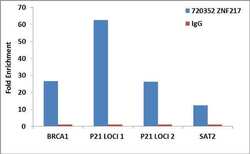
- Experimental details
- Enrichment of endogenous ZNF217 protein at specific gene loci using Anti-ZNF217 Rabbit Polyclonal Antibody: Chromatin Immunoprecipitation (ChIP) was performed using Anti-ZNF217 Rabbit Polyclonal Antibody (Product # 720352, 3 µg) on sheared chromatin from 2 million HeLa cells using the MAGnify ChIP system kit (Product # 49-2024). Normal Rabbit IgG (1 µg) was used as a negative IP control. The purified DNA was analyzed by 7500 Fast qPCR system (Product # 4351106) with optimized PCR primer pairs for the promoters of the active P21, BRCA region used as positive control target genes, and the region of the inactive SAT2 satellite repeat, used as negative control target gene. Data is presented as fold enrichment of the antibody signal versus the negative control IgG using the comparative CT method.
Supportive validation
- Submitted by
- Invitrogen Antibodies (provider)
- Main image
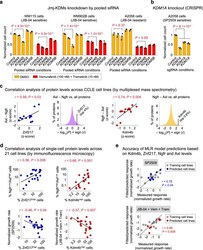
- Experimental details
- Fig. 6 Kdm4b and Znf217 protein levels predict differentiation state-specific sensitivity to JIB-04 and SP2509. a Relative cell viability in WM115 cells (left), WM902B cells (middle), and A2058 cells (right) following treatment with indicated doses of the combination of vemurafenib and trametinib or vehicle (DMSO) in the presence of pools of four siRNAs targeting either KDM4A , KDM4B , KDM5A , or KDM5B for 96 h. Viability data for each treatment condition were normalized to cells treated with DMSO and the non-targeting (control) siRNA. Data are presented as mean values +- s.d. calculated across n = 3 biologically independent experiments. Statistical significance was determined by two-sided t test. b Relative cell viability in Cas9-positive A2058 cells following treatment with three different types of KDM1A lentiviral single guide RNA (sgRNA) for 96 h. Viability data were normalized to cells treated with non-targeting (control) sgRNA. Data are presented as mean values +- s.d. calculated across n = 4 biologically independent experiments. Statistical significance was determined by two-sided t test. c Two-sided Pearson''s correlation analysis of variations in the difference between Ngfr and Axl protein levels and Znf217 (left panels) or Kdm4b (right panels) in comparison with the rest of the measured proteome (shown as histograms) across BRAF -mutant melanoma cell lines. Protein data are extracted from the Cancer Cell Line Encyclopedia (CCLE) proteomics database (measured by mult
- Submitted by
- Invitrogen Antibodies (provider)
- Main image
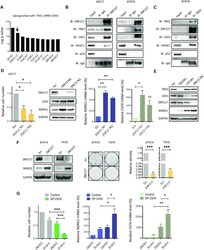
- Experimental details
- Figure 4. TBX2 interacts with components of the CoREST repression complex. ( A ) TF signature enrichment (ChEA database) of genes upregulated by TBX2 knockdown after 72h as determined by microarray. CoREST factor ZNF217 is indicated in the top 10 enriched terms by the arrowhead. ( B ) Western blot of Co-IP in MCF7 and BT474 cells. ZNF217 was precipitated from lysates using anti-ZNF217 antibody, with species-matched IgG as control IP. Samples were immunoblotted for ZNF217, TBX2, CoREST positive controls (LSD1, HDAC1) and negative control (p53). ( C ) Western blot of Co-IP in BT474 cells. TBX2 was precipitated from lysates using anti-TBX2 antibody, with species-matched IgG as control IP. Samples were immunoblotted as described above. ( D ) MCF7 cells were treated with two independent ZNF217 siRNAs or scrambled control for 72 h. Effects on proliferation were measured by relative cell number; impact on protein levels of ZNF217 and NDRG1 were detected by western blot; effects on mRNA of NDRG1 and CST6 were assessed by RT-qPCR. ( E ) Western blot from MCF7 lysates following treatment with TBX2/LSD1/ZNF217 siRNA for 72 h. Samples were probed with antibodies against each target, to assess mutual dependency for protein expression; effects on NDRG1 upregulation are shown. ( F ) BT474 and T47D cells were treated with ZNF217 siRNA (equimolar pool of sequence#1/sequence#2) or scrambled control for 96h. Effects on protein level of ZNF217 and NDRG1 were detected by western blot; clonogenic
 Explore
Explore Validate
Validate Learn
Learn Western blot
Western blot